‘Russian dwarf hamster’ is a term used for two different species of hamster, the Campbell’s dwarf hamster and the Winter White. They are very similar in appearance, care and behaviour but this care guide will focus specifically on the Campbell’s hamster (we have a separate care guide for Winter White hamsters).
Caring for any type of dwarf hamster is pretty simple and just requires a little bit of knowledge. The guide below will cover everything from diet and cages to taming and breeding. Enjoy!
The Campbell’s Dwarf Hamster - Appearance, Colors and Key Info
Campbell’s hamsters are the most common dwarf hamsters you’ll find in the pet store. This popularity has led to breeders all around the world producing different colors and variants of this hamster breed. There are over 40 different coat colorations currently available!
Scientific name
Phodopus campbelli
Other names
Fancy hamster
Russian dwarf hamster
Sometimes also called the Djungarian hamster
Lifespan
1.5 – 2 years
Size
4 inches (10cm)
Campbell’s Dwarf Hamster Appearance And Colors
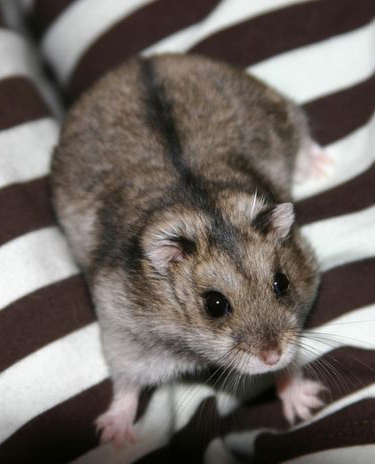
The Campbell’s hamster is very similar in appearance to the Winter White. Due to selective breeding there are a tonne of different color variants out there and some seriously beautiful hamsters as a result! Campbell’s hamsters have a solid dorsal stripe on their back.
A distinguishing characteristic of this species is the darker fur on their back that changes to a creamy color on the sides and becomes very white on the belly. Here are some common coat colors you can find in pet stores:
- agouti (the normal greyish color)
- argente (cinnamon/sandy)
- albino (white)
Lots of campbell’s hamsters have red eyes and this is perfectly normal. It’s worth noting that not all white hamsters are albino, they may just be lighter platinums. There are a few things that distinguish this hamster from the other breeds:
- Cream colored fur between back and belly
- Campbell’s hamsters stay the same color, Winter Whites become lighter during colder months
- Winter Whites tend to have softer coats
How Long Does A Campbell’s Dwarf Hamster Live For?
Hamsters have short lifespans and this species is no different, living for 1.5-2 years. Syrian and Roborovski hamsters tend to live a little longer than this.
That’s not necessary a bad thing as shorter lifespans can be a much better fit for first-time pet owners. You have time to develop a bond without needing a much longer commitment such as 10+ years with a dog.
Where Does The Campbell’s Dwarf Hamster Come From?
Campbell’s hamsters were originally discovered in Mongolia back in 1902. The man who first found these small creatures was named W.C. Campbell and that’s how they got their name! These hamsters can also be found in northern China, central Asia and parts of Russia.
In the wild, Campbell’s dwarf hamsters dig incredibly deep burrows and this is where sleeping, eating and mating takes place. The burrows are also used to hide from potential predators. The temperature inside these burrows remains cool which is perfect for raising up baby Campbell’s hamsters!
The burrows can actually be pretty complicated systems, with multiple openings and exists for safety. This is partly why dwarf hamsters enjoy tunnels and tubes when kept in captivity. At night Campbell’s hamsters will take to the surface on the lookout for food, bedding material and anything else that’s useful! Miles will be covered by a single hamster every night.
Are Campbell’s Dwarf Hamsters Good Pets?

They are amazing little pets! All dwarf hamsters make enjoyable pets and Campbell’s are right up there – they’re the most popular dwarf hamster for a reason.
Campbell’s dwarfs are good matured animals and will only nip if feeling threatened. Dwarf hamsters can be a little harder to handle due to their agility and speed but with a little practice you’ll get there. Winter Whites have been known to be easier to tame but Campbell’s are certainly a lot easier to tame than Roborovski hamsters.
Campbell’s dwarf hamsters are nocturnal, just like the rest of the hamster family. That shouldn’t pose too much of a problem as you’ll have plenty of time to bond with your pet in the evenings which is when most people arrive home from work anyway. Try not to wake your hamster during its sleeping hours very often.
Campbell’s Vs. Winter White Vs. Hybrid Hamsters
There are three types of hamster which are very closely related. These are Campbell’s, Winter Whites and hybrids.
If Winter White and Campbell’s hamsters are bred together, their offspring is called a ‘hybrid’. These hamsters can be quite controversial in the pet industry. Unfortunately hybrids often develop health issues and other problems later in life. In short, Campbell’s and Winter Whites shouldn’t really be bred together.
Of course, there are some hybrids that have absolutely no problems and make good pets too but it’s always best to buy a purebred. This is particularly true as the breeding process between a Winter White and Campbell’s hamster isn’t always pleasant.
Both Campbell’s and Winter White dwarf hamsters make perfect pets for the home. They are very similar in appearance and very similar to care for, just with a few slight differences. Whatever your personal preference, both these animals will make loving companions and prove very rewarding to look after.
If you can’t tell whether you have a Campbell’s or Winter White then take a look where the body color of your hamster meets its whiter underside. If there’s a cream color between the darker body and whiter belly of your hamster then you likely have a Campbell’s dwarf. A more sudden transition would indicate you have a Winter White.
Here are some other quick checks you can make:
- Campbell’s hamsters usually have a thinner and lighter dorsal stripe
- Campbell’s hamsters have a leaner appearance (Winter Whites have a rounder body)
- Campbell’s dwarfs stay the same color where Winter Whites gradually turn whiter as winter approaches
It’s never easy to tell these breeds apart but hopefully that helps!
Campbell’s Dwarf Hamster Minimum Cage Size
Always try to purchase the largest cage you can afford for your hamster. The more space for these animals to run and explore, the better! The minimum cage size for a Campbell’s dwarf hamster is considered to be 24 inches long and 12 inches wide. This is basically the equivalent of a 20-gallon aquarium.
What’s The Best Cage For A Campbell’s Hamster?
There are a number of good cages available online, we listed our favourite hamster cages here. A word of warning, be careful when purchasing cages with metal bars as sometimes these are purpose built for Syrians and dwarf hamsters can squeeze through the gaps!
You don’t want to be running after a small Campbell’s hamster so stick to a cage with small bar spacing. Another option is to go for a glass aquarium. This is perfectly fine as long as you ensure there is enough space and ventilation for your pet.
The Savic Hamster Heaven - Our Favourite Hamster Cage
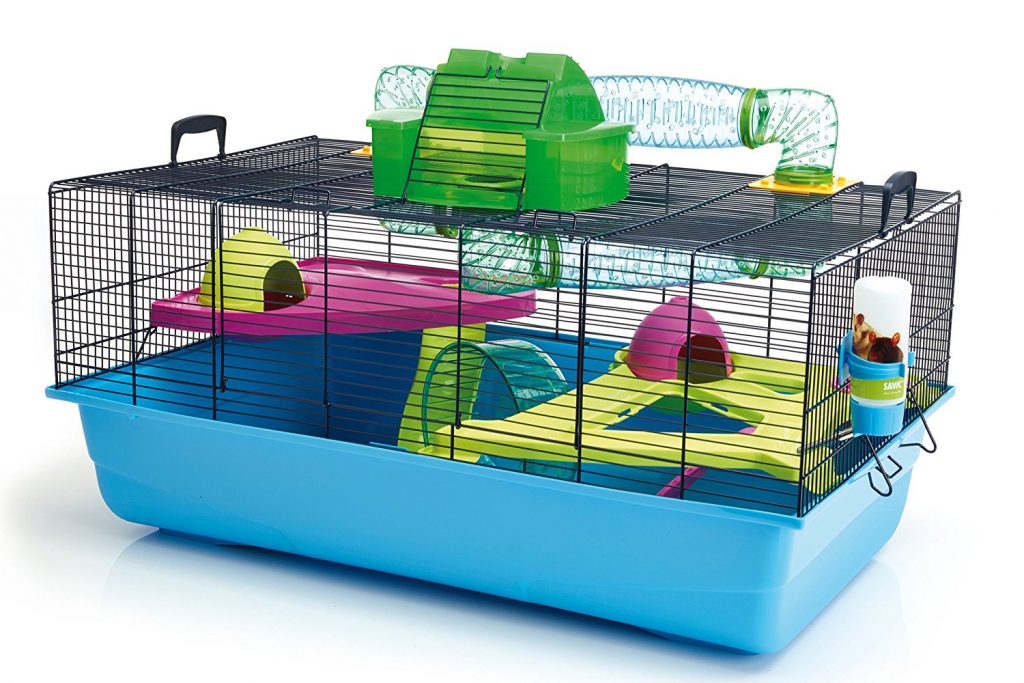
This is by far the best hamster cage you can buy today. It provides plenty of room for your hamster to explore and is capable of holding a small group of Robos. Lots of accessories are included with the set while being easy to assemble and clean – click here for more details on the Savic cage.
20 Gallon Glass Aquarium - A Blank Canvas
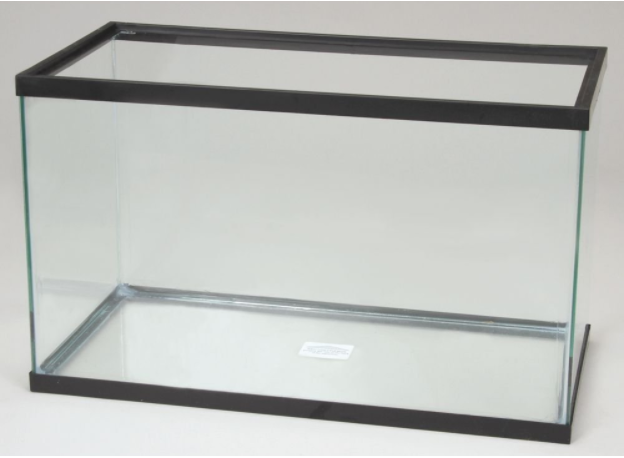
A cheaper option is the classic 20 gallon aquarium. This is a blank canvas and allows you to create any enclosure design you wish. No metal bars mean your hamster isn’t going to find a way out of this anytime soon!
How To Take Care Of A Campbell’s Dwarf Hamster
Keeping a Campbell’s dwarf hamster happy isn’t too difficult. Just make sure you purchase a cage big enough for however many hamsters you’d like to keep and provide a balanced diet with fresh water.
Hamster toys are more important than you might think. Campbell’s hamsters love to play so they need plenty of activities to keep their mind busy. A good hamster wheel should be at the top of your shopping list as these animals don’t stop running!
Campbell’s hamsters are most prone to diabetes out of all the hamster breeds. That means you need to feed a high quality food mix with healthy treats and fresh fruit but not too much sugar. Also, be sure to give your pet some wooden chewing toys as a hamster’s teeth never stop growing!
A food bowl will give your hamster somewhere to regularly check for food and it will probably greet you there at feeding time! Consider purchasing two bowls if you’re keeping multiple hamsters as this will help reduce aggression and territorial behaviour at meal time.
You’ll need a high quality substrate and bedding material for the bottom of your cage. This will absorb any mess and needs replacing weekly. Aim to clean your cage once every week with a pet-safe disinfectant spray. This will maintain a clean, bacteria-free environment for your pet and keep your hamster very happy indeed!
How much does it cost to look after a Campbell’s hamster?
The biggest cost is buying all the equipment needed to set up your cage. Once that’s finished you’ll only need to be purchasing food, bedding, treats and toys which certainly doesn’t add up to much. Hamsters are one of the cheapest pets you could own.
- Hamster cage – $30
- Hamster wheel – $10
- Toys – $15
- Hamster house (hiding area) – $5
- Substrate/bedding – $10
- Food bowl and water dispenser – $10
- Food mix – $10
- Campbell’s hamster – $10
Approx. cost = $100
Campbell’s Dwarf Hamster Behaviour and Temperament
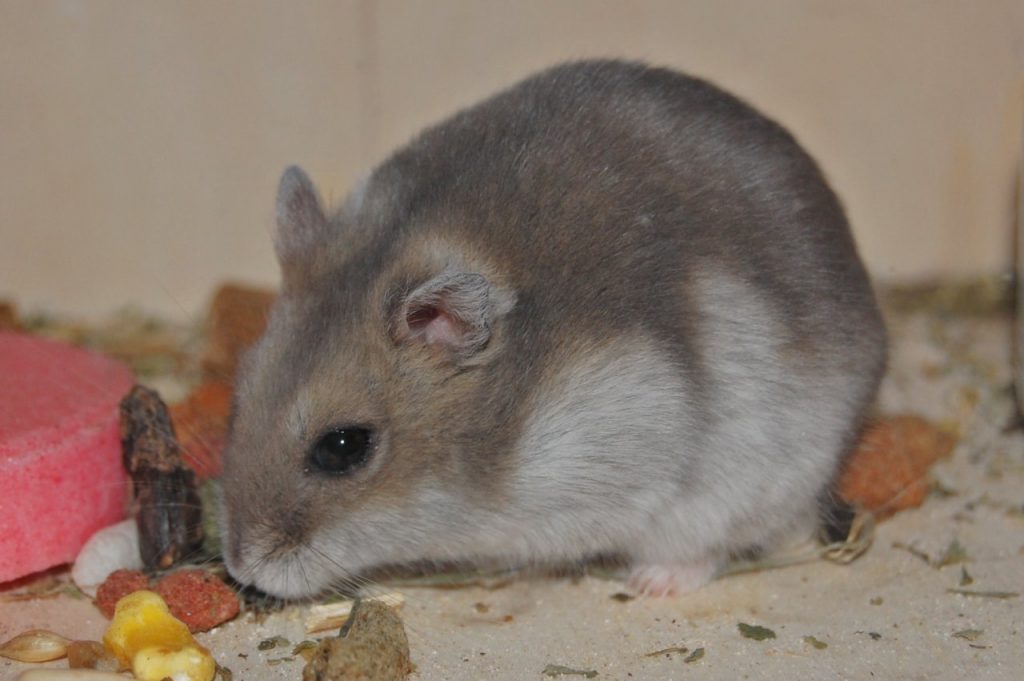
Campbell’s hamsters are nocturnal animals that are most active during evening and nighttime hours. They’ll spend that time exploring, burrowing, running, playing with toys and eating. All dwarf hamsters will wake up now and again during the day but not for long periods. Our lunch is their midnight snack!
This is a soft-natured breed of hamsters but probably a little more flighty than their Winter White cousins. Once you’ve built a bond with your pet handling shouldn’t be an issue. These hamsters absolutely love their treats which is why they can be tamed using food-based rewards.
Are Campbell’s Hamsters Safe For Children?
They are great pets for the whole family! As long as you are careful when interacting with the animal then there shouldn’t be any problems. Handling is probably best left to older children as Campbell’s hamsters are delicate and can’t be dropped from any real height.
They’re also more agile and a lot faster than Syrians which can make handling a little harder but practice does make perfect. Children always enjoy watching a dwarf hamster race across the floor in a hamster ball, just remember to always supervise them during handling time.
Do Campbell’s Dwarf Hamsters Bite?
All hamsters bite but only when threatened. Take it slow when building a bond with your pet and learn to understand your hamster’s body language. The #1 cause of bites is attempting to pick up your hamster from above. This imitates a predator’s behaviour so always scoop from below to avoid this issue.
Best Toys For A Campbell’s Dwarf Hamster (Enrichment Guide)
Enrichment is important when keeping a hamster. These are active little animals that need plenty of activities to keep them happy and healthy. Exercise wheels are a must but you can also provide tunnels, climbing frames, burrowing toys and so much more! Toilet roll tubes make good cheap toys as well.
Best Hamster Wheel For A Robo
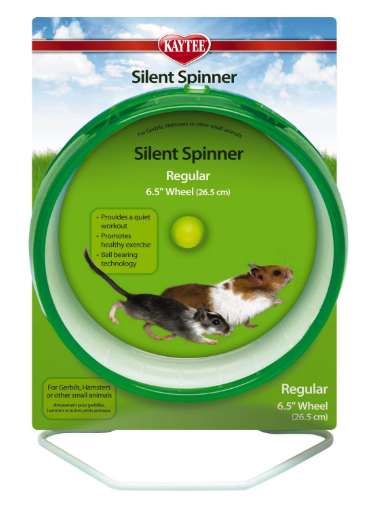
A good hamster wheel is an absolute must for your cage. Roborovskis are incredibly active and you’ll probably notice that they’re always on their wheel in the pet store!
That’s why Kaytee silent spinner is the perfect option. At the time of writing, it’s available for only $12.99 (see latest price here) and has the added bonus of being silent. You don’t want to be waking up every night to an annoying squeaking sound coming from your hamster cage – trust me!
Always go for a silent hamster wheel, it will be very beneficial for the long run. Most cages come equipped with a standard wheel that squeaks non-stop when in use.
Climbing Frame Hamster Toy

A good climbing frame for your hamster can improve quality of life and provide a new challenge for your pet. The natural living tunnel toy encourages natural behaviours in your pet while, providing an all-new activity for your pet. It’s really fun watching a dwarf hamster navigate the toy, exploring all the different areas. Click here for latest price.
Sturdy Hamster Exercise Ball
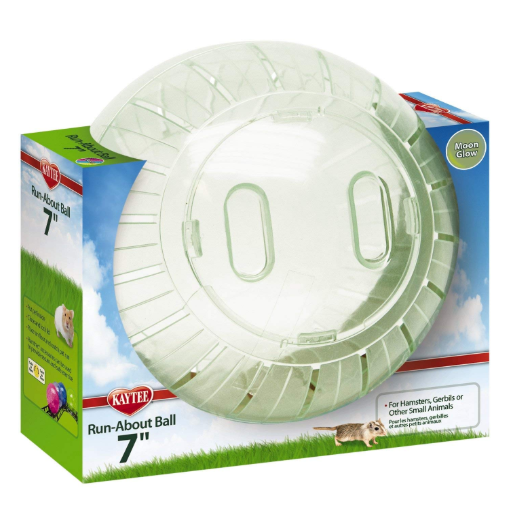
The Kaytee Run-About hamster ball is another must-buy for your pet. This allows you to keep a Campbell’s hamster occupied while you carry out weekly cage cleaning duties. Some hamster balls easily break open when in use, resulting in an escaped hamster to look for! That’s why it’s better to go for quality in this department. Click here to check the latest price.
Hamster balls are also perfect for kids. You can allow children to enjoy and interact with their dwarf hamster without the need for handling.
How To Handle And Tame A Campbell’s Dwarf Hamster
Taming your hamster is definitely achievable with regular handling sessions. After taming your dwarf hamster, you’ll be able to pick him/her up whenever you’d like! This definitely makes life easier, particularly when it comes to cleaning. It’s also a rewarding feeling to build enough trust between you and your hamster that it enjoys your company.
To tame your dwarf hamster, here’s the best strategy:
- Give your hamster some space for a few days after purchasing
- Softly talk to your hamster and offer it treats, this will get it used to your scent and voice
- Carefully stroke your hamster whenever possible and offer treats as a reward
- After some time, start putting your hand flat on the bottom of the cage and allow your hamster to climb on and explore
- Gently scoop your hamster from underneath and handle your pet
- Slowly increase height over the next few days to build trust
Campbell’s Hamster Feeding Guide
In the wild, Campbell’s dwarf hamsters will eat a variety of nuts, grains, seeds, vegetables and even insects. They also love fresh fruits but always feed this in moderation. Feeding a balanced diet is probably the most important part of hamster keeping so do your research, your pet’s livelihood depends on it. Here’s a more detailed guide on feeding a dwarf hamster.
Campbell’s hamsters expend a lot of energy during the night so go for a quality food mix that’s high in protein and vitamins. They also love to eat insects, particularly mealworms, so go ahead and feed this if you’re not too afraid of the creepy crawlies!
Tiny Friends Farm Hazel Hamster Mix
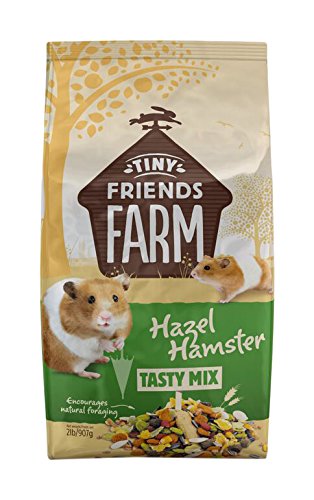
The Tiny Friends food mix is perfect for a picky dwarf hamster. It’s a great tasting mix of seeds, mealworms and other healthy treats. This food mix can also be used for Syrians, making it a much more versatile option for pet keepers. Click here to see the latest price of this food mix.
Key Benefits:
- A great tasting food mix
- The best food mix for fussy hamsters
- Nutritionally balanced
- Suitable for all hamster breeds
- Added vitamins and includes mealworms
- Promotes natural foraging
How Much Should You Feed A Campbell’s Hamster?
Campbell’s dwarf hamsters need around one tablespoon of food mix per day (per hamster). You can supplement fresh fruit, insects and packaged treats on top of this. Just remember to feed treats sparingly as Campbell’s hamsters are very prone to diabetes.
Can Campbell’s Dwarf Hamsters Live Together?
Campbell’s hamsters love company. Unlike Syrians, you can keep this hamster breed either alone or as part of a group. It’s always best to go for same sex groups to avoid fighting and unexpected pups.
Campbell’s are not as territorial as other hamster breeds which is why they’re more sociable as a species. It’s really interesting to watch your hamsters interact and it can be pretty entertaining too! Never put Campbell’s hamsters together with any other species of hamster, even Winter Whites.
Campbell's Dwarf Hamsters Fighting?
The best way to avoid arguments in your group is to firstly purchase hamsters that have grown up together, preferably from the same litter (if you don’t plan to breed). There are other measures you can take to reduce territorial behaviour such as purchasing a larger cage. You can also provide your pets with multiple food bowls, hamster wheels and sleeping areas to avoid squabbling over a specific area.
How To Breed A Campbell’s Dwarf Hamster

Campbell’s dwarf hamsters will start breeding as early as 3 months old. They stay pregnant for around 20 days and a female will usually produce 4-6 pups. Hamsters can actually mate on the same day as giving birth however this isn’t a healthy practice and should be avoided.
One of the reasons this hamster breed is so popular is because of how easy they are for breeders to reproduce. Females will give off a special ‘heat’ scent for the male which indicates she is ready to reproduce; this happens every 4 days.
Simply pair a suitable male and female together and there’s a good chance you’ll see pups within a month. Always keep the pair separate from other hamsters and remove the male for a few days while the pups are still newborns. Then he can be reintroduced to tend to his young, this is simply to protect the female.
Please note that breeding should only be carried out by experienced hamster owners and you must have a plan to re-home the newborns once they are mature.
A Summary
So that’s everything you need to successfully look after a Campbell’s dwarf hamster! Hopefully this guide has helped you provide a healthier, happier and more educated home for your new pets. If you’re interested in other elements of hamster care, do browse the DwarfHamsterGuide blog for all the information you could ever need.
